Spiders have long been the subject of fascination and fear. These eight-legged creatures, belonging to the arachnid family, can be found in various habitats around the world. From tiny jumping spiders to large tarantulas, there are over 45,000 known species of spiders inhabiting almost every corner of our planet.
But what do we really know about their behavior? Spiders tend to evoke mixed reactions among people.
Some fear them and consider them creepy crawlies while others appreciate their role in controlling populations of other insects. Regardless of our personal feelings towards them, it’s important to understand that spiders are incredibly diverse in their habits and traits.
Are Spiders Attracted to Light? This question has perplexed many curious minds for quite some time.
We often find ourselves wondering whether light influences spiders’ behavior or if they are simply indifferent to it. It’s true that many insects are attracted to light sources such as lamps or porch lights, but what about our arachnid friends?
To begin uncovering the truth behind this puzzling phenomenon, we must delve into the intricate intricacies of spider behavior and examine how certain species react to different light stimuli. So buckle up as we embark on a journey through spider secrets and explore whether they have a natural sense for seeking out those bright illuminations or if it’s all just an old wives’ tale!
The Attraction to Light Phenomenon
Explanation of phototaxis – the movement towards or away from light
The fascinating behavior of spiders in relation to light is rooted in a phenomenon called phototaxis. Phototaxis refers to the instinctual movement of creatures towards or away from light sources.
While some organisms are positively phototactic, meaning they are attracted to light, others display negative phototaxis and tend to avoid it. Spiders fall into both categories, with different species exhibiting distinct responses.
Different responses of spiders to light stimuli
When it comes to spiders’ response towards light stimuli, there is no one-size-fits-all approach. For instance, the most common house spiders, such as cellar spiders and orb-weavers, typically avoid direct exposure to bright lights. They are more comfortable building their intricate webs in dark places where they can easily catch unsuspecting insects.
These spiders have a natural sense that tells them bright lights may in turn attract spiders’ predators or discourage their prey. On the other hand, some species like wolf spiders display positive phototaxis and are indeed attracted to light sources.
Unlike web-building spiders that patiently wait for bugs to fly into their carefully crafted traps, wolf spiders rely on active hunting techniques. They use their excellent vision and quick reflexes to chase down prey.
As a result, they might be necessarily attracted by the potential abundance of insects drawn towards illuminated areas. The response of each spider species varies due to a combination of evolutionary adaptations and ecological factors that shape their behavior patterns regarding light influences.
Understanding these diverse reactions helps shed light on how we can deter bugs while maintaining a balance between keeping our homes insect-free and respecting the natural instincts of these small but sophisticated arachnids.
Natural Habitat and Ecological Adaptations
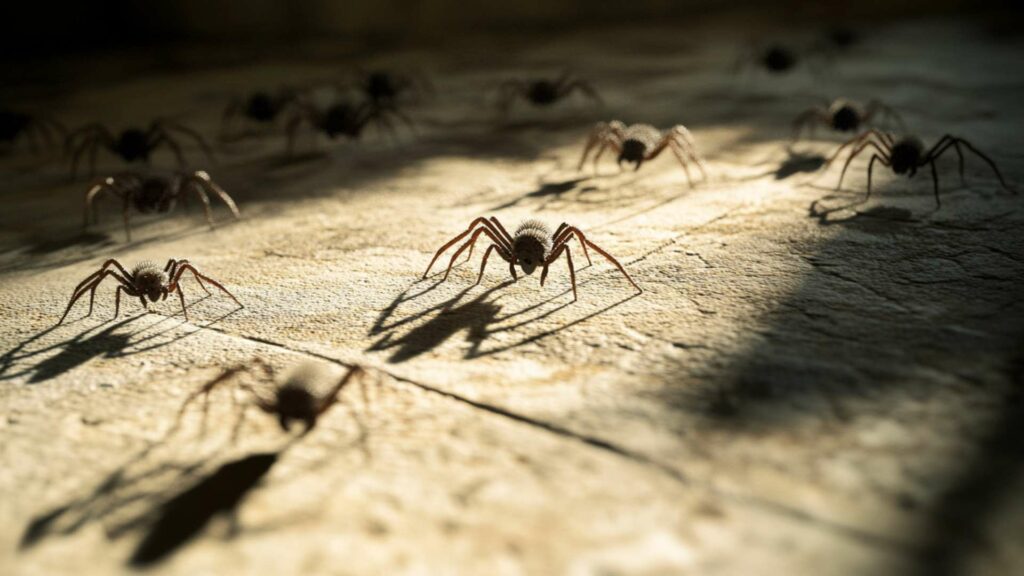
Spiders, those fascinating eight-legged creatures that often send shivers down our spines, have evolved over millions of years to adapt to different natural habitats. One crucial factor influencing a spider’s attraction to light is whether it belongs to a nocturnal or diurnal species.
Nocturnal spiders are primarily active at night, while diurnal spiders prefer the daylight hours for their hunting and mating activities. Nocturnal species, such as the common house spider, tend to seek dark corners and crevices during the day.
They hide away from predators and conserve energy until darkness falls when they venture out in search of food. These spiders have adapted their hunting techniques to take advantage of the cover darkness provides.
On the other hand, diurnal species, like some garden orb-weaving spiders, are more active during daylight hours because many insects they prey upon are more abundant then. Another important consideration is whether a spider is a web-building or hunting species.
Web-building spiders rely on their intricate silk webs to attract insects and catch flying insects attracted by outdoor lights. They strategically position themselves near these lighting sources where an abundance of potential meals can be found.
Hunting spiders, such as jumping or wolf spiders, use their keen senses to actively pursue prey rather than relying on static webs. Their attraction to light might differ from that of web-building spiders due to variations in their hunting strategies.
Role of Instinct and Evolutionary History
The instinctive behavior of spiders also plays a significant role in determining their attraction or aversion towards light sources. This instinct has been shaped through countless generations by evolutionary pressures related to prey attraction and reproduction.
For instance, some spider species are naturally drawn towards light because it acts as an enticing beacon for potential meals—namely flying insects that swarm around outdoor lights at night. The light serves as a convenient trap for these hapless insects, and spiders have honed their ability to capitalize on this natural attraction.
By positioning themselves near lighting sources, spiders increase their chances of capturing abundant prey while expending minimal energy. In terms of reproduction and mate-seeking behavior, some spider species display interesting light-related behaviors.
Male wolf spiders, for example, perform rhythmic leg tapping dances in response to female visual signals during courtship. These displays often occur in low-light conditions or darkness and might serve to attract mates while minimizing the risk of attracting predators.
Prey Attraction and Hunting Strategies
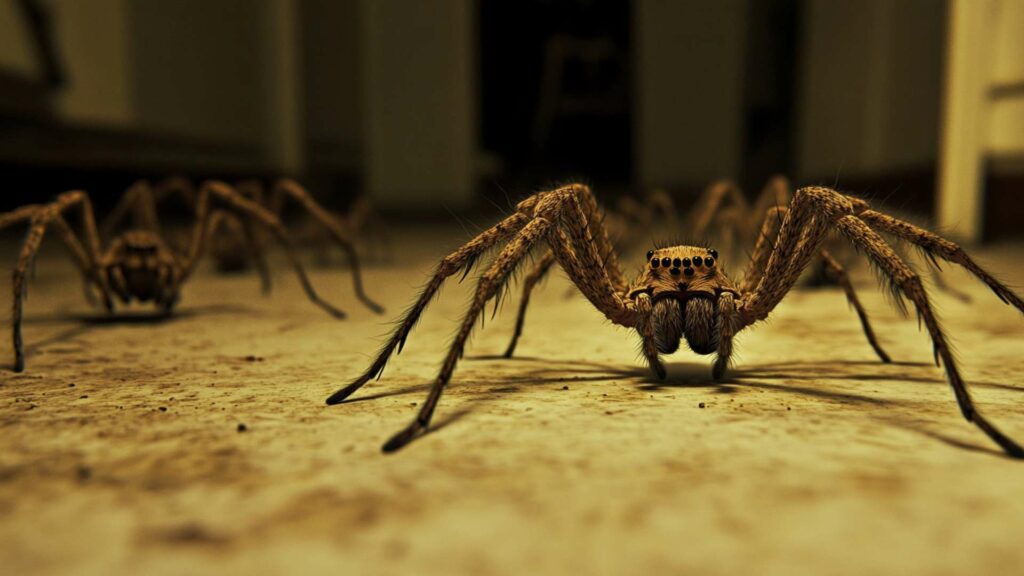
Spiders’ attraction to light can also be attributed to their hunting strategies. As mentioned earlier, outdoor lights often attract an array of flying insects that become easy prey for web-building spiders. These lights act as beacons that draw in unsuspecting moths, mosquitoes, and other flying insects which then find themselves entangled in the spider’s finely woven silk.
Additionally, certain spider species possess specialized visual adaptations that make them more efficient hunters under specific lighting conditions. For instance, some jumping spiders are known for their acute vision and exceptional color sensitivity.
They can detect ultraviolet light and have precise depth perception—skills they use to accurately judge distances when pouncing on unsuspecting prey. It is essential to note that not all spider species are attracted to light in the same way or even at all.
While some may exhibit a strong affinity towards light sources due to evolutionary factors or hunting strategies, others may actively avoid light as it increases their vulnerability to predators or disrupts their natural behavior patterns. So next time you spot a spider lurking near a well-lit area—whether it’s seeking prey spiders hiding out under an outdoor lamp or weaving its web near your porch light—remember that its fascination with light stems from its unique ecological adaptations and instinctual behavior patterns rather than a universal trait among all spider species.
Types of Lights that Attract Spiders
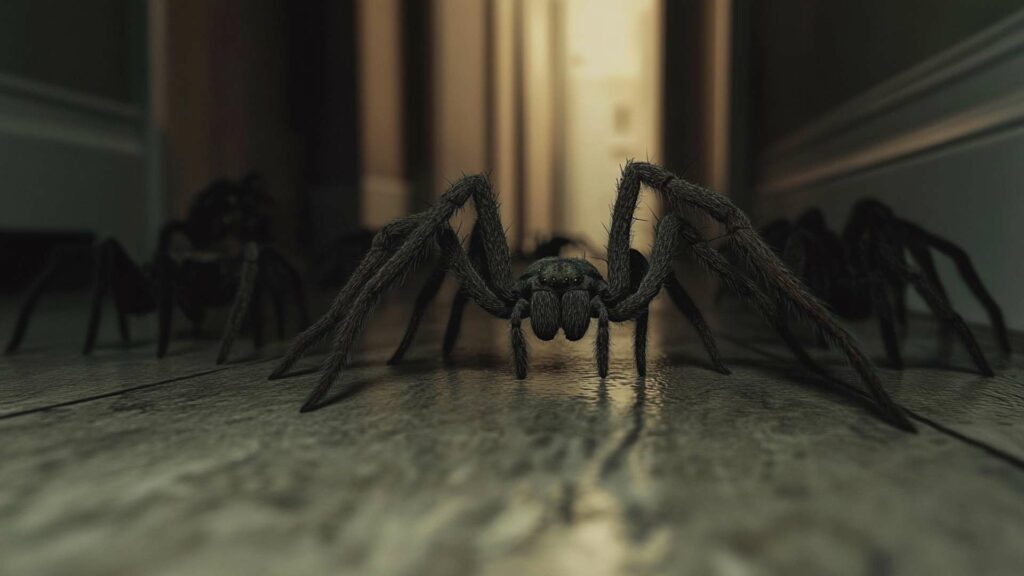
Incandescent lights vs. LED lights
When it comes to the question of whether spiders are attracted to light, the type of light source plays a significant role. Incandescent lights and LED lights emit different wavelengths of light, which can have varying effects on spider behavior. Incandescent lights produce a warm, yellowish glow, while LED lights offer a brighter and cooler illumination.
Differences in wavelengths emitted
Spiders are generally more attracted to incandescent lights than LED lights due to the difference in wavelengths emitted. Incandescent bulbs emit more infrared and ultraviolet light, which appeals to nocturnal spiders fewer insects that rely on these ranges for hunting prey and finding mates. The warmth and color temperature produced by incandescent bulbs mimic natural moonlight, creating an enticing environment for certain spider species.
Impact on spider behavior
Light intensity also plays a crucial role in attracting or repelling spiders. Bright lights can lure flying insects near outdoor sources, such as porch lights or streetlights. These insects then become potential food sources for spiders that are drawn to the area.
However, it’s important to note that not all spider species are equally attracted to light; diurnal spiders may be less affected by artificial lighting since they are adapted to dark corners and avoid predators during daylight hours. Spider’s response to different colors is another fascinating aspect related to their attraction or aversion towards light sources.
While some studies suggest that certain spider species may be more attracted to specific colors such as white or yellowish hues (which resemble the color of most insects), it’s important not to generalize this response across all types of spiders. The relationship between color preference among various spider species is still an area of ongoing research.
While bright lights can attract flying insects near outdoor sources like porch lights, the impact of light on spider behavior varies among different species. Incandescent lights tend to emit wavelengths that appeal to certain spider species, mimicking natural moonlight and enticing nocturnal spiders that rely on infrared and ultraviolet light for hunting and mating.
However, not all spiders are attracted to light equally, as diurnal spiders may have different behavioral patterns and preferences. Understanding how light influences spiders can help us better appreciate their role in ecosystems while also finding ways to coexist peacefully with these fascinating creatures.
Spiders’ Relationship with Artificial Light Sources
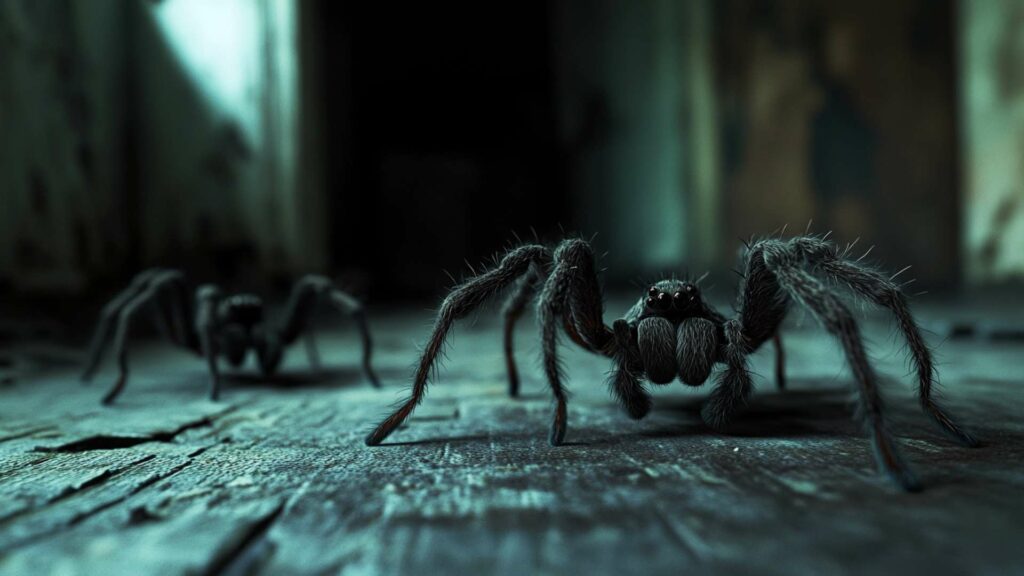
Impact on spider populations in urban areas
In urban environments, where artificial lighting sources are abundant, spiders’ behavior can be significantly affected by light bulbs. Light pollution from streetlights, buildings, and other sources can disrupt the natural rhythms and patterns of spiders.
This disruption can lead to changes in their population dynamics and distribution. Many nocturnal spider species may be drawn to these bright lights, which can result in an increase in their numbers around urban areas.
Light pollution effects on spider behavior
Light pollution not only influences spider populations but also alters their behavior. For some species of hungry spiders, bright light can disrupt their hunting patterns as it tends to attract various flying insects.
Instead of staying hidden in dark corners or discreetly weaving their webs away from light sources, spiders may become more active around lights as they take advantage of the abundance of prey that is drawn to them. This phenomenon creates a unique ecological relationship between spiders and artificial lighting sources.
Changes in web-building patterns
The availability of outdoor lights has been observed to impact the structure and location of spider webs. Some common house spiders that typically construct their webs away from human activity may shift closer to outdoor lights where they have a higher chance of capturing flying insects attracted by the light source. Furthermore, these brightly lit locations provide a consistent food source for spiders, allowing them to thrive in these areas.
Interactions with Indoor Lighting
Spiders attracted to indoor lights: reasons & prevention
Indoor lighting can also draw spiders towards our homes. The presence of artificial light at night can confuse certain species hate spiders that are naturally attracted to bright light sources like moths or other flying insects. Spiders tend to follow these insects indoors through open doors or windows inadvertently left ajar.
To prevent unwanted encounters, it is advisable to keep doors and windows properly sealed and well-fitted with screens. Additionally, using curtains or blinds to block the visibility of indoor lights from the outside can reduce the likelihood of spiders being attracted indoors.
The role of cobwebs near light sources
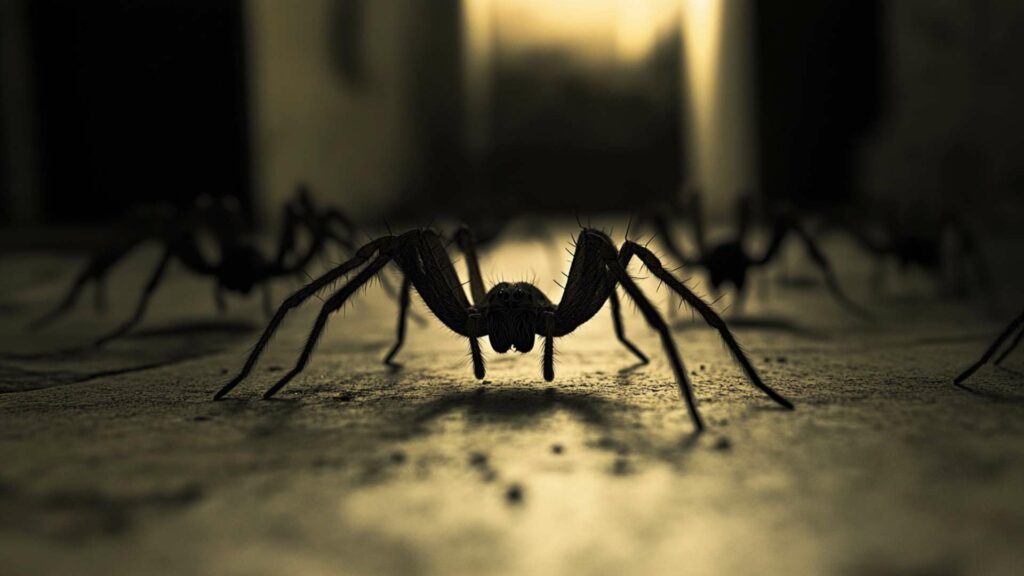
You may have noticed cobwebs forming near light sources in your home. Spiders spin their webs strategically in locations where they are more likely to attract bugs and capture prey.
By placing their webs near indoor lights, spiders take advantage of flying insects that are drawn towards the light source. These lights attract fewer insects that inadvertently fly into the web, providing a convenient source of food for the spider.
Therefore, finding cobwebs near your indoor lighting fixtures is not necessarily an indication of neglect but rather a testament to spiders’ resourcefulness in capturing their next meal. Artificial lighting sources play a significant role in influencing spider behavior and populations.
Light pollution can disrupt natural patterns and attract nocturnal species towards urban areas. Spiders adapt to take advantage of these lighting sources by altering their hunting strategies and adjusting web-building locations accordingly.
While interactions with indoor lighting can lead to unwanted encounters with spiders indoors, preventive measures such as sealing openings and blocking visibility can help minimize these occurrences. So, next time you spot a spider near a light source, remember that it might just be taking advantage of the abundance of prey that comes with it!
Myths, Misconceptions, and Fascinating Facts about Spiders and Light
Common misconceptions about spiders being attracted to light
One common misconception is that all spiders are naturally attracted to light. While some spider species show a tendency to move towards light sources, this behavior is not universal. In fact, many spider species avoid light altogether.
It is crucial to understand that spiders do not have an inherent attraction to light; their responses vary depending on the species, habitat, and other factors. Therefore, assuming that all spiders are drawn towards light can lead to misunderstandings.
Fascinating adaptations related to the spider’s vision system
Spiders possess remarkable adaptations when it comes to their vision system. Contrary to popular belief, most spiders do not rely heavily on their eyesight for hunting or navigation. However, they can still perceive certain visual cues in fascinating ways.
For instance, some spider species have developed exceptional night vision capabilities that allow them to hunt prey more efficiently under low-light conditions. These nocturnal hunters have specialized eyes designed for capturing even the tiniest glimmers of moonlight or starlight.
Night vision capabilities
The night vision capabilities of certain spider species are truly captivating. Some female nocturnal spiders have a layer of specialized cells in their eyes called tapetum lucidum which reflects incoming light back through the retina, enhancing sensitivity in low-light situations. This adaptation enables these spiders to detect subtle movements of prey even in near darkness or dimly lit environments.
Ultraviolet sensitivity
Another intriguing aspect of spider vision is its sensitivity to ultraviolet (UV) light. Some flying insects reflect UV rays in patterns invisible to humans but highly noticeable by spiders with UV-sensitive eyesight.
This ability helps them locate potential meals effortlessly and also plays a role in courtship rituals. Additionally, spider silk, the incredible material used to produce silk threads and webs, is often UV-reflective, aiding spiders in detecting and assessing the condition of their intricate traps.
Conclusion
While it is not accurate to claim that all spiders are necessarily attracted to light, some species do exhibit light-seeking behavior. Many spiders have evolved remarkable adaptations related to their vision system that allow them to navigate and hunt successfully in various lighting conditions.
Understanding these intricacies helps dispel common misconceptions surrounding spiders and their interaction with light sources. So, next time you come across a spider scurrying away from or towards a source of artificial light, take a moment to appreciate the fascinating adaptations that make these arachnids both impressive and integral components of our ecosystem.
Conquering Spiders with D-Termination: The Foremost Pest Control in Las Vegas!

Worried about the presence of spiders in your Las Vegas property? Look no further than D-Termination for the perfect solution. Our team of experts is skilled at eradicating spider infestations, bringing back serenity and calm to your space. Bid farewell to spiders—opt for D-Termination’s effective pest control today!
Reach out to us at 702-919-6310 or visit dtermination.com to schedule your spider control service and regain your space from these unwanted pests.
Frequently Asked Questions:
Leaving the light on might discourage some spiders.
Nighttime light can attract insects, which in turn may attract spiders.
Spiders can become more noticeable when lights are on.
Factors like warmth and prey might attract spiders indoors.







